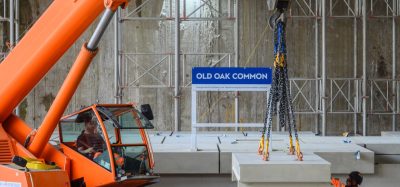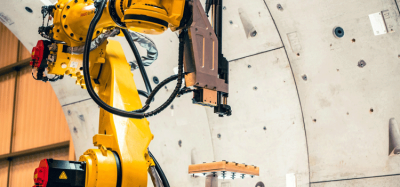Driving under the Gotthard complete and the Ceneri is on course
Posted: 4 August 2011 | | No comments yet
On 23 March 2011, between Faido and Sedrun in Switzerland, miners excavated the last metres of rock of the Gotthard Base Tunnel. Both single-track tubes are therefore now continuously bored over their full length of 57 kilometres. In the Ceneri Base tunnel, the main drives from the Sigirino intermediate heading, as well as the inward drives from both portals, are in progress.
The Gotthard Base Tunnel
Since the second final breakthrough on 23 March 2011, the Gotthard Base Tunnel is completely cut. Lining work in the Erstfeld, Sedrun and Faido sections is progressing according to plan. At Bodio West, installation of the railway infrastructure for the test section is in progress.
On 23 March 2011, between Faido and Sedrun in Switzerland, miners excavated the last metres of rock of the Gotthard Base Tunnel. Both single-track tubes are therefore now continuously bored over their full length of 57 kilometres. In the Ceneri Base tunnel, the main drives from the Sigirino intermediate heading, as well as the inward drives from both portals, are in progress. The Gotthard Base Tunnel Since the second final breakthrough on 23 March 2011, the Gotthard Base Tunnel is completely cut. Lining work in the Erstfeld, Sedrun and Faido sections is progressing according to plan. At Bodio West, installation of the railway infrastructure for the test section is in progress.
On 23 March 2011, between Faido and Sedrun in Switzerland, miners excavated the last metres of rock of the Gotthard Base Tunnel. Both single-track tubes are therefore now continuously bored over their full length of 57 kilometres. In the Ceneri Base tunnel, the main drives from the Sigirino intermediate heading, as well as the inward drives from both portals, are in progress.
The Gotthard Base Tunnel
Since the second final breakthrough on 23 March 2011, the Gotthard Base Tunnel is completely cut. Lining work in the Erstfeld, Sedrun and Faido sections is progressing according to plan. At Bodio West, installation of the railway infrastructure for the test section is in progress.
Status of work on the Gotthard Base Tunnel Overground section Altdorf-Rynächt
Along the overground approach line to the Gotthard Base Tunnel, various structures such as underpasses, bridges, passages and retaining walls are being built. Work on these objects continues.
In July 2011, work on installing the railway systems also began at the north portal of the Gotthard Base Tunnel. For this to be possible, extensive preparatory work was necessary. Along the overground section, the railway systems installations site at Rynächt was constructed. This will serve as the operational base for installation of the railway systems in the north, similar to the railway infrastructure systems installation site at Biasca in the south. Between now and the autumn of 2011, workshops and halls, office buildings, a control centre, a canteen, and visitor rooms will be erected on the approximately 70,000m2 site. Already in the autumn of 2010, the tracks from the installations site were joined to the existing Swiss Federal Railways network in the direction of Altdorf to allow the transport of machines and materials. Close to the north portal, the Erstfeld railway systems building has been constructed and is already being fitted out. When in operation, it will be used to accommodate various railway system installations.
Erstfeld section
Work on the cut-and-cover tunnel at Erstfeld is progressing according to plan. At the end of 2010, the east cut-and-cover tunnel had been completely joined to the mined portal, while 70 metres of the west cut-and-cover tunnel remained to be completed. Concrete lining of the Erstfeld section is largely complete.
Amsteg section
In both tubes of the section, the concrete shell is complete and ready for the railway systems to be installed. In first preparations for the installation phase, in mid-2010 the general contractor for railway infrastructure began installing radio and landline telecommunications systems. At the power-supply feed-in point at Amsteg, a railway systems building is under construction.
Sedrun section
In the last year, the blasting drives towards the south passed through the geologically favourable formation of striated gneisses as well as through the Piz Fuorcla zone, which is characterised by variable geological conditions. In parts, additional securing means such as steel rings as well as additional normal and advance anchors were necessary. As driving progressed, the rock overburden increased from 2,300 to 2,500 metres.
At 2:17 PM on 15 October 2010, the final breakthrough took place. The tunnel boring machine (TBM) from Faido broke through into the Sedrun section. With a deviation of 8cm horizontally and 1cm vertically, the breakthrough error was minimal. After the breakthrough, the TBM was dismantled in a cavern that was specially constructed for this purpose, and the individual parts were transported out of the tunnel.
Final breakthrough by the tunnel boring machine in the parallel west tube, also from the south, took place shortly after midday on 23 March 2011. At breakthrough, the west TBM had cut through 11,088 metres of rock from the multifunction station at Faido and 29,220 metres from the south portal at Bodio. Dismantling of the TBMs began at the end of March 2011 and is expected to continue until August 2011.
Faido section
Following completion of the TBM drives, the main focus of work in the Faido section is on lining of the cross galleries, concreting of the inner lining, and sealing work in the area of the tunnel crossovers. Fitting out of the multifunction station is also in progress.
Bodio section
Since May 2010, the west tube of the Bodio section is the first section of the Gotthard Base Tunnel to be completely fitted out with the railway system installations. In a first step, the railway systems general contractor installed temporary systems in the tunnel to supply electric power, telecomunications and lighting to the construction site. These were followed by optical-fibre cables and medium-voltage cables as well as installation of the permanent railway track, which was completed at the end of March 2011. The catenary is now being installed as well as electromechanical equipment in the cross galleries.
Gotthard South/Biasca section
In May 2011 on the south overground section between Biasca and Osogna, the first implementation work for connection of the AlpTransit line to the Swiss Federal Railways main line began. For the Nodo della Giustizia connection, important structures are being built, which include a bridge over the Froda Canal, the Giustizia cut-and-cover tunnel, and a retention basin for the Stabiello stream. The cantonal road will also be routed over the new cut-and-cover tunnel.
Outlook – milestones to opening of the Gotthard Base Tunnel
Increasingly, the focus of construction work will be on the tunnel lining, infrastructure systems and railway installations. In the summer of 2010, installation of the railway systems started from the south portal of the Gotthard Base Tunnel. In the last six months in this section, work on the construction shell, electromechanical equipment and railway systems proceeded in parallel. In a test phase starting here in 2014, the interplay of all of the installed railway systems will be tested. The findings will have signal significance for the commissioning and commercial opening of the Gotthard Base Tunnel. At the beginning of 2016, in test operations with trains, the interplay of the technical installations in the Gotthard Base Tunnel will be tested. At the end of May 2016, AlpTransit Gotthard Ltd. will hand over the tunnel to the Swiss Federal Railways ready for operations. Scheduled train services will be possible from December 2016.
The Ceneri Base Tunnel
On 20 October 2009, AlpTransit Gotthard Ltd. and the consortium of construction contractors signed the work contract for the main work on the Ceneri Base Tunnel. The contract value for this main lot, which primarily covers driving of both single-track tubes north and south from the intermediate heading at Sigirino, is approximately 1 billion Swiss francs (price level 2008). Two other consortia are tasked with the inward drives from the north portal and two further consortia from the south portal. Work is currently in progress on 10 driving faces of the Ceneri simultaneously.
Status of work on the Ceneri Base Tunnel Sigirino intermediate heading
Excavation of both tubes is taking place exclusively by conventional drilling and blasting. After taking over the surface installations, on 4 January 2010, the main contractor also took over the underground construction sites and began blast-driving in March 2010. Driving is taking place in the east and west single-track tubes both northwards and southwards. In the summer months of 2010, belt conveyors of the single-track tubes, the concrete plant in the operations cavern, and ventilation installations were constructed. Since September 2010, blastdriving has been progressing at all four cutting faces. For logistical supplies to the driving areas, hanging platforms have been installed. The excavated rock is transported on belt conveyors out of the tunnel to the landfill site at Sigirino.
The work of the consortium also includes aspects of the inner lining, electromechanical equipment, ventilation for the railway systems, and spoil management.
North portal at Vigana
In the area of the north portal of the Ceneri at Vigana, because of the small vertical distance to the A2 motorway and the Swiss Federal Railways line, as well as the loose ground, driving had to proceed with great caution and in close coordination with the Swiss Federal Office for Roads. Following completion of both preliminary cuttings, driving work began in June 2009. By May 2010, driving for the singletrack portal of the new Lugano–Bellinzona section was complete, and excavation work was being continued in the adjoining west cavern. At the dual-track Vigana portal (new Bellinzona–Lugano section and Lugano–Locarno connecting loop), the 20m-wide tunnel vault of the crown was constructed with the aid of a horizontal umbrella of jetting columns (in loose material) and with a tube screen (in the transitional zone to the rock). These umbrellas that were installed as construction aids were first mounted on abutments built into the pilot shafts and thereby solidly supported.
By the end of 2010, 105m of the crown had been driven and 56m of the bench. Driving in the area affected by the A2 motorway was thus also successfully completed here, and the excavation work could be continued in the adjoining east cavern. With a cross-gallery further inside the mountain from the west cavern (west axis), it was also possible to access the axis of the east singletrack tube, so that in May 2011 the driving faces in both single-track tubes were around 500 metres inside the mountain.
Nodo di Camorino
Work on the Nodo di Camorino has been in progress since 2006. The new four-track railway bridge over the A2 motorway will replace the existing two-track bridge. So as not to interfere with railway operations, two tracks of the new structure will first be built alongside the existing bridge. This will allow diversion of the two tracks for demolition of the old bridge and construction of the second half of the new bridge. The abutments and pillars for the first half of the bridge have been constructed. The falsework for shuttering and concreting the bridge supports is ready. By October 2010, the concrete shell of the new Swiss Federal Railways bridge over the Morobbia river was also complete. In the underpass of the cantonal road, excavation in the central section is complete and the ramp in the direction of Bellinzona is being dug.
In April 2010 the main work north of the cantonal road began, with demolition of existing and temporary built structures. On 16 December 2010, the work contract for the approximate 1km-long Lugano–Bellinzona viaduct was signed. Construction work on this central structure of the Nodo di Camorino started at the beginning of 2011. Construction work for the 400m-long Bellinzona–Lugano viaduct is scheduled to start in 2012.
Vezia south portal and overground section
So that excavation of the tunnel above the Vedeggio–Cassarate road tunnel is complete before the latter is opened to traffic, from spring 2010 the 300m-long reverse drive could be rapidly driven in good geology and thanks to good cooperation with the neighbouring municipalities and others involved. The crossover point with the road tunnel was reached ahead of schedule in July 2010. By the end of 2010, the drive was already out of the area affected by this crossover point, so the punctual commissioning of the Vedeggio–Cassarate road tunnel (cantonal road) is not affected. By April 2011, for both single-track tubes the crown had already been excavated for the full length of 300 metres. This was followed by excavation of the bench along a length of approximately 200 metres. The preliminary cutting is now being converted into the 170m-long cut-and-cover tunnel. Construction work for the adjoining overground section to the south as far as the Massagno Tunnel comprises various subprojects. Since September 2010, uphill of the Swiss Federal Railways line a 650m-long retaining wall and other noise-abatement walls have been under construction. The work is being closely coordinated with the Swiss Federal Railways and is on course.
About the Author
Renzo Simoni has been working at AlpTransit Gotthard Ltd since 1 April 2007. His past employment includes working for Helbling Beratung + Bauplanung AG, Ernst Basel + Partner AG and Gruner AG. Mr. Simoni studied civil engineering at ETH Zurich and also took a Postgraduate Diploma in Spatial Planning, plus writing a Doctoral Thesis at the ORL Institute.







